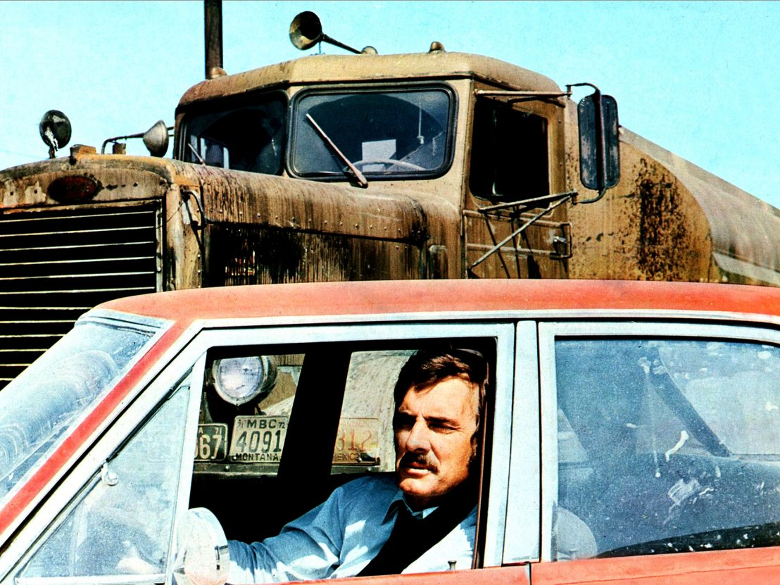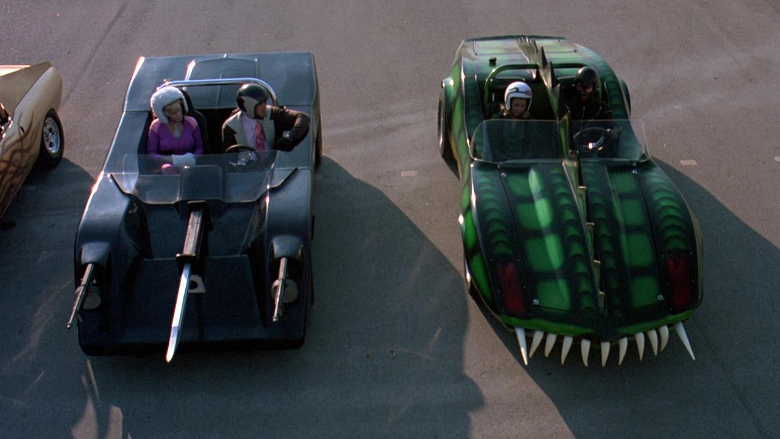At the dawn of the twentieth century, the role of vehicles became highly important. Serving as a symbol of freedom, one can simply get behind the wheel and control your destiny by roaming the open highways, joining the ranks of celebrated wanderers like Jack Kerouac. However, these liminal byways and ley lines that connect us to the rest of the world are also capable of leading danger directly to us. One wrong turn can guide a driver directly to their own doom. It comes as no surprise that so many filmmakers hit the pavement for inspiration when it comes to their horror movies. Thus, a proliferation of car horror movies.
Personally, I have developed a healthy fear of vehicles being raised by a long line of mechanics. So buckle up as we assess a variety of tropes associated with car horror movies.
Picking Up Strangers
Hitchhiking, whether by circumstance or lifestyle, is a classic trope in horror. Life on the road is dangerous: the vulnerability of needing a lift to civilization and the gamble of peril we place ourselves in when someone stops are both factors to be concerned about. Or just imagine that a good Samaritan pulls over to help a stranded commuter with the best of intentions that may or may not pave the road to hell. When was the last time you invited death into your car?
1953’s The Hitch-Hiker is American film noir shot through the eyes of a woman, director Ida Lupino. Serving as an early entry in the car horror movies universe, it follows 2 fishing buddies on a trip to Mexico. Picking up a hitchhiker that happens to be a spree killer, the men are terrorized and humiliated by their captor on the lam. The movie was inspired by events surrounding the real-life mass murderer, Billy Cook.
What followed is a string of hitchhiking thriller movies, though 1986’s The Hitcher sticks out (its thumb) the most. A young man driving from Chicago to San Diego picks up a roadside traveler, hoping they would help keep him awake. Instead, he’s stalked and tormented by a serial killer, thriving on the fringes of society and evading capture – the very reason your mother tells you not to pick anyone up.
Of course, not all who wander the highways are murderers looking for a ride; some sit behind the wheel of a tractor-trailer. The granddaddy of car horror movies is Steven Spielberg’s 1971 Duel. The script was adapted by Richard Matheson from his own short story, the inspiration of which came from a personal experience of being tailgated by a trucker the same day Kennedy was assassinated. An influential cult thriller of emasculation and gas lighting, Duel follows a salesman antagonized by a tanker truck on a business trip. The film established Spielberg as a director and lead a convoy of entries in a subgenre of anonymous truckers terrorizing commuters. The best representation is 2001’s Joy Ride, a cheesy but thrilling road horror of friends driving cross country. Making crank calls on a CB radio, they decide to have a little fun with a trucker who happens to be a psychopath.

Hitchhikers and truckers have their supernatural counterparts, four-lane folklore shared at truck stops and roadside diners across the globe. Ghostly hitchhikers are picked up by motorists, only to vanish without explanation from the car seat. Variations have been traced as far back as the 1870s, Resurrection Mary being more modernly recognizable.
On the flip side of the coin are travelers picked up by truckers, only to discover that they hitched a ride with the dead. “Phantom 309” is a spoken folk song about a trucker that gives a lift to a stranded wanderer, who later discovers his ride was a spirit. Based on a true event, different variations of the story circulated in modern culture including Large Marge.
Haunt My Ride
Though television had its first evil car in an episode of The Twilight Zone in 1964, the first movie was 1977’s The Car. A seemingly possessed vehicle stalks and runs down the residents of a sleepy desert town. The car itself is a customized Lincoln Continental with blacked out windows, no plates, no handles, and no driver. Though never referenced, it bears a similar appearance to the Soviet Union’s GAZ Volga. Only manufactured in black, this model was the center of urban legends across Europe. One of these legends, The Black Volga, claimed that an evil vehicle was kidnapping adults and children alike. Some versions claim the Volga is possessed while others insist it’s driven by the secret police, priests, or Satan himself.
The most widely recognized subject of paranormal road horror is Stephen King’s 1983 novel, Christine. It was followed with a film adaptation directed by John Carpenter, in less than a year. It follows an awkward teen buys a Plymouth Fury as a fixer-upper, transitioning to manhood and automotive spirit possession. Themes of Arnie’s unnatural love for his car was further explored in the film and may have been provoked by J.G. Ballard’s 1973 novel Crash, though neither can compare to Isaac Asimov’s 1953 short story, “Sally.”
Though the vehicle as a vessel for disturbed souls or infernal imps remains constant in the ever-evolving road horror trope, the film The Toybox gives the audience a RV camper containing the spirit of a serial killer. Loosely inspired by the real-life events surrounding David Parker Ray (trigger warning for the link), better known as the “Toybox Killer,” a man who had converted a tractor trailer into a soundproof torture chamber.
Similarly, China’s 2008 film Ju-On Car (Killer Car) puts the disembodied soul of a crash victim under the hood, making the car sentient and angry. Even the time traveling Delta 88 from the Evil Dead franchise is prone to demonic possession in season 2 of Ash VS The Evil Dead. On the other side of the world, it seems that South Korea must have a problem with undead Ubers prowling city streets at night. In the road horror comedy, Gongpo Taxi (Terror Taxi), a young cabbie is killed in a hit & run accident, only to return as a phantom taxi driver doomed to haunt the roads. Along the way he meets others like him that actually enjoy their work of terrorizing humans in ghost rides.
1986’s The Wraith follows a teenager murdered by car racing street-toughs, returning to this world for vengeance with an invulnerable Turbo Interceptor. Super Hybrid is an Australian sci-fi road horror film about man-eating, shape shifters. Having studied humanity’s obsession with car culture, they choose a vehicular form to stay at the top of the food chain.
In a different medium is Killdozer!, the sci-fi/horror novella by Theodore Sturgeon. Originally published in Astounding magazine in 1944, it covers an ancient alien energy unearthed at a construction site in which it possesses a Caterpillar D7 bulldozer, affectionately referred to as Daisy Etta. The 1974 film of the same name features an unearthed meteorite that possessed the bulldozer and joys rides on a murder spree. Thus, we are brought to more science fiction elements of car horror movies.
Dystopian Driving
Too many times, popular culture has been warned about The End coming in a cloud of dust and exhaust. The Mad Max film franchise and Tank Girl comics reinforce this apocalyptic vision of the future. However, Maximum Overdrive is an excellent unconventional apocalypse film for those nostalgic for Y2K. Adapting his own short story “Trucks,” Stephen King directed this movie of the Earth crossing the tail of a comet, resulting in all machinery becoming sentient and destroying human life. A small band of blue-collar humans are trapped in a truck stop, hunted down by big rigs one by one. This premise was reimagined in 1997 with the USA original TV-movie, Trucks, which runs closer to King’s short story.
Another great dystopian flick and a punksploitation comedy in its own right, Repo Man feels like an alternate timeline. Sci-fi Western meets road flick set in the Radioactive Reagan-era, a rookie repo man gets mixed up with car thieves and a UFO cult. All the while, he is hunting down a mad scientist’s Chevy Malibu hauling nuclear cargo. The synchronicities in the background remind the audience that society is about as insignificant as a plate of shrimp.
In another antiquated future, bloody motorsports are a high form of entertainment in Roger Corman’s Death Race 2000. Based on the IB Melchior short story “The Racer,” this brutal car horror movie has a totalitarian regime running the country. Holding a transcontinental race where points are rewarded for running down pedestrians, politics collide with reality TV and population control.

Australia offers a wide variety of retro-futuristic road horror cinema. 1974’s The Cars That Ate Paris was never intended to be a not-too-distant-future film, but it surely wouldn’t surprise anyone in current times. Set in the rural town of Paris, an isolated community with an economy completely based on car crashes, greaser punk youths & their customized doom-mobiles set fatal traps for tourists passing through. Wreckage is scavenged for barter, from luggage to auto parts in a manner reminiscent of The Hills Have Eyes or Texas Chainsaw Massacre. Survivors are subjected to lobotomy experiments in the town asylum or adopted by townsfolk to replenish numbers.
This concept was lightly revisited in 1986’s Dead End Drive-In, where cars are a commodity in a collapsed economy. Roving gangs of car-punks and tow companies scavenge parts and drive-in theaters are converted to concentration camps. Another example is Killing Cars, an 80s cyberpunk car horror movie from West Germany. It’s more of a neo-noir thriller, about corporate espionage trying to stop an environmentally friendly car from reaching the masses. Complete with violent squatter punks, it takes the idea of road horror from monster cars to monstrous corporations. 12 years later would come the real-life inventor, Stanley Meyer. He claimed to have created a water powered motor by equipping a dune-buggy with a fuel cell that split water atoms to burn hydrogen and release oxygen. Mysteriously, he died in a parking lot in 1998 with the last dying words “they poisoned me.” His water-powered car was stolen one week after his death.
Car-nage
The bubble of security within a vehicle can quickly dissolve into a mere facade within unconventional road horror movies. A mother and son are forced to take shelter in a Ford Pinto in 1983’s film adaptation of Cujo.
— FOUNDATIONS OF HORROR —
Further explore these subgenres and tropes. more>>
#Sci-fi horror | #Technology is scary | #Action horror

A suffocating prison of temporary safety, the same scene was set in 2016’s The Monster. In this car horror movie a mother and daughter cower in their car from a beast in the woods about to devour them like a can of sardines. Let’s not dismiss the suspenseful sibling spree in Ari Aster’s Hereditary, certain to suck the air from your lungs for the film’s most iconic 15 minutes.
Park It
When discussing car horror movies, while the car is a tool of liberation, it also can place its driver in a position of vulnerability. That vulnerability can be found whether a couple on lover’s lane is approached by a maniac with a hook or an innocent drive through the countryside quickly turns into a chainsaw massacre nightmare. The open freedom that comes with traveling brings a terrifying unknown around every curve. So as gas prices continue to soar during the peak of road trip season, perhaps we should rethink our relationships with automobiles. Buckle up and drive safe.
Last Updated on July 21, 2022.

